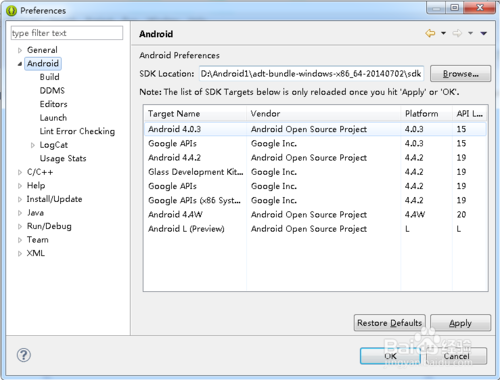- Adt Bundle Windows X64 2014 Crack
- Adt Bundle Windows X64 2014 Download
- Adt Bundle Windows X64 2014 Download
- Adt Bundle Windows X64 2014 64
Prerequisites
- Adt-bundle-windows-x0.zip - Google Drive.
- The source code for the Android 4.2 Jelly Bean operating system is released, and the SDK is available for download which means we would be able to see custom ROMs available pretty soon from developers, and only for those who have the Android 4.2 OS in their devices.
- دانلود Android SDK / ADT Bundle x86/x64 2014-07-02 + SDK Release 24.3.4 Win/Linux/Mac - دانلود محیط فوق العاده ی برنامه نویسی اندروید دانـــلود کــنید.
- Mathematics Typesetting Tool for Windows. Environment on Windows x64.
Windows PC: A computer running XP or any later version of Windows operating system will do fine, i.e., XP, Vista, 7, 8, or any later version.
Java: Java 6 or later must be installed on your computer, because it’s required by the Android SDK Bundle. Install the latest available Java version for your platform.
Wednesday, September 3, 2014. ADT Bundle For Windows x86 x64 + Apktool Tampilan Adt Bundle for Windows Tampilan Apktool. Posted by diPhonS X at.
Android SDK Bundle: The latest version of Android SDK bundle is required. Download and extract the file into a directory. You will see a folder named 'adt-bundle-windows-…' This folder is referred to as the “Android SDK Folder' for the remainder of this tutorial. It contains two folders named “eclipse' and “sdk', and one file named “SDK Manager.exe'.
Android SDK packages: Open “SDK Manager.exe' from the Android SDK Folder. Check “Android 4.2.2 (API 17)' in the SDK Manager. This gives you the necessary SDK packages for running Android in a virtualized environment.
- SDK Platform
- ARM EABI v7a System Image
- Google APIs.
Create And Run Android Virtual Device
Open “SDK Manager.exe' from the Android SDK Folder. Browse to Tools > Manage AVDs. The Android Virtual Device Manager will open.
Click on the New… button (top right) and you will see the Create new Android Virtual Device (AVD) window appear. Configure the new AVD as per the following configurations:
| AVD Name: | Any name |
| Device: | Galaxy Nexus (4.65', 720 x 1280: xhdpi) |
| Target: | Android 4.2.2 – API Level 17 |
| CPU/ABI: | ARM (armeabi-v7a) |
| Keyboard: | Checked |
| Skin: | Checked |
| Front Camera: | None |
| Back Camera: | None |
| Memory Options – RAM: | 768 |
| Memory Options – VM Heap: | 32 |
| Internal Storage: | 200 MiB |
| SD Card – Size: | 500 MiB |
| Emulation Options- Snapshot: | Unchecked |
| Emulation Options – Use Host GPU: | Unchecked |
You can now view it in the list of existing AVDs in the AVD Manager. Congratulations on creating your first Android Virtual Device!
Adt Bundle Windows X64 2014 Crack
App Installation In AVD
Installing An App
With AVD running, download the apk file for UC Browser Mini from AppsZoom (search for your app, open the page for your app from the search results, click on Download tab in the opened page, and click on the option to direct download APK file).
Copy the downloaded file to 'Android SDK Foldersdkplatform-tools'.
Open the command prompt from the Start menu or screen then type:

Type “adb start-server' at the prompt. It should report that the daemon started successfully.
Type “adb devices' at the prompt. It should report a connected device with “emulator'. If no device is reported, then you may not have started the AVD. Restart, wait for the android’s home screen, and re-type “adb-devices' at the prompt.
Type “adb install <APK File>' at the prompt, after changing <APK File> with the name of the .apk file (of the android app) you want to install in the AVD. For example, the .apk file on our test sytem was named “ucb-mini.apk', so the command changes to adb install ucb-mini.apk.

Wait while ADB pushes the APK file into the AVD and installs it. It might take some time depending on the size of the app which you’re installing. When the installation is complete, It should report success.
Uninstalling An App
Troubleshooting
Welcome to the Chocolatey Community Package Repository! The packages found in this section of the site are provided, maintained, and moderated by the community.
Moderation
Adt Bundle Windows X64 2014 Download
Every version of each package undergoes a rigorous moderation process before it goes live that typically includes:
- Security, consistency, and quality checking
- Human moderators who give final review and sign off
Adt Bundle Windows X64 2014 Download
More detail at Security and Moderation.
Organizational Use
If you are an organization using Chocolatey, we want your experience to be fully reliable. Due to the nature of this publicly offered repository, reliability cannot be guaranteed. Packages offered here are subject to distribution rights, which means they may need to reach out further to the internet to the official locations to download files at runtime.
Fortunately, distribution rights do not apply for internal use. With any edition of Chocolatey (including the free open source edition), you can host your own packages and cache or internalize existing community packages.
Adt Bundle Windows X64 2014 64
Disclaimer
Your use of the packages on this site means you understand they are not supported or guaranteed in any way. Learn more...
